Optimized Resonant Network Design for High Energy Transfer Efficiency of the WPT System
Abstract
:1. Introduction
- An active LCC-S-type resonant network design with dual-SCC topology is provided.
- The output performance characteristics of the LCC-S compensated resonant network with variable series and parallel compensation capacitances are analyzed.
- A comprehensive optimization algorithm is applied to optimize the regulation process of SCCs.
- The WPT system with the active compensation network is able to get the CV output and high operating efficiency when coils are misaligned in various directions.
2. Circuit Analysis of the Active LCC-S Compensated Network
2.1. Steady-State Analysis of the Active LCC-S Compensated Network
2.2. The SCC Circuit
3. Control of the Active LCC-S Compensated Network
3.1. Effects of α and β on System Output Voltage Gain and Efficiency
3.2. The Nondominated Sorting Genetic Algorithm II
- Step 1: Initialize the population and set the evolution counter Gen = 1.
- Step 2: If the first offspring population is generated, let Gen = 2. Otherwise, conduct nondominated sorting and selection, crossover, and mutation for the initial population to generate the first offspring population and make Gen = 2.
- Step 3: Combine the parental population with the offspring population to form a new population.
- Step 4: If a new parental population has been generated, go to Step 5. If not, the fitness values of the individuals in the new population should be calculated, and the operations such as fast nondominant sorting, calculation of crowding degree, and elite strategy are performed to generate a new parental population.
- Step 5: Conduct selection, crossover, and mutation for the generated parental population to generate the offspring population.
- Step 6: Check whether the termination criteria are satisfied. If not, make Gen = Gen + 1 and go back to Step 3. Otherwise, stop the algorithm loop.
3.3. Adoption of NSGA-II and Analysis for Calculation Results
- Keep the output voltage gain Gv constant when the coil’s coupling condition changes.
- Let the operating efficiency of the WPT system be as high as possible at the same time.
3.4. Control Strategy
- First, according to the application and actual working conditions of the WPT system, the design of its basic parameters is determined, including Ls1, L1, L2, Cs1(o), Cp1(o), C2, etc.
- Ls1, L1, L2, and C2 are considered as constant, then let the value of M vary in the range of 50% M0–100% M0 at intervals of 1 μH to calculate the optimal parameters α and β through NSGA-II, and the corresponding equivalent control angles θs1 and θp1 can be determined according to (5) and (10). The data of θs1 and θp1 are recorded as an array varying with M, and they are stored in the controller.
- In the practical operating process, the initial values of equivalent control angles θs1 and θp1 are both set as π/2, to make the equivalent capacitances of SCC-Cs1 and SCC-Cp1 be Cs1(o) and Cp1(o), individually. This means that the active WPT system is operating as the classical tuned system at first.
- When the output of the WPT system with initial parameters becomes stable, the actual output voltage |Uout| will be detected, and the actual voltage gain could be calculated by (11). As a result, the actual M can be estimated.
- 5.
- According to the estimated value of M, the values of θs1 and θp1 will be replaced. Therefore, the equivalent capacitances of SCC-Cs1 and SCC-Cp1 will be regulated to the proper values, to guarantee that the optimized CV output and the high-efficiency performance of the WPT system will be obtained.
4. Discussion
4.1. Experimental Condition
4.2. Experimental Results
5. Conclusions
Author Contributions
Funding
Data Availability Statement
Conflicts of Interest
References
- Vu, V.-B.; Tran, D.-H.; Choi, W. Implementation of the Constant Current and Constant Voltage Charge of Inductive Power Transfer Systems with the Double-Sided LCC Compensation Topology for Electric Vehicle Battery Charge Applications. IEEE Trans. Power Electron. 2018, 33, 7398–7410. [Google Scholar] [CrossRef]
- Chen, Y.; Zhang, H.; Shin, C.-S.; Jo, C.-H.; Park, S.-J.; Kim, D.-H. An Efficiency Optimization-Based Asymmetric Tuning Method of Double-Sided LCC Compensated WPT System for Electric Vehicles. IEEE Trans. Power Electron. 2020, 35, 11475–11487. [Google Scholar] [CrossRef]
- Mai, R.; Luo, Y.; Yang, B.; Song, Y.; Liu, S.; He, Z. Decoupling Circuit for Automated Guided Vehicles IPT Charging Systems with Dual Receivers. IEEE Trans. Power Electron. 2020, 35, 6652–6657. [Google Scholar] [CrossRef]
- Fereshtian, A.; Ghalibafan, J.; Koohestani, M. A comprehensive design analysis of a cost-effective WPT system with a class-E power amplifier and a T-matching network. AEU Int. J. Electron. Commun. 2021, 137, 153826. [Google Scholar] [CrossRef]
- Atallah, H.A.; Huseein, R.; Abdel-Rahman, A.B. Novel and compact design of capacitively loaded C-shaped DGS resonators for dual band wireless power transfer (DB-WPT) systems. AEU Int. J. Electron. Commun. 2019, 100, 95–105. [Google Scholar] [CrossRef]
- Jeong, I.-S.; Lee, Y.-K.; Choi, H.-S. Characteristics analysis on a superconductor resonance coil WPT system according to cooling vessel materials in different distances. Phys. C Supercond. Its Appl. 2016, 530, 123–132. [Google Scholar] [CrossRef]
- Ji, L.; Wang, L.; Liao, C.; Li, S.; Ma, J. Research and design of automatic alternation between constant-current and constant-voltage modes on the secondary side in wireless charging systems. IET Electr. Power Appl. 2020, 14, 1119–1126. [Google Scholar] [CrossRef]
- Kumar, A.; Bertoluzzo, M.; Jha, R.K.; Sagar, A. Analysis of Losses in Two Different Control Approaches for S-S Wireless Power Transfer Systems for Electric Vehicle. Energies 2023, 16, 1795. [Google Scholar] [CrossRef]
- Jose, J.; Therattil, J.P. WPT compensation topology optimized for PV embedded electric vehicle. Sustain. Energy Technol. Assess. 2022, 53, 102605. [Google Scholar] [CrossRef]
- Ahmad, A.; Alam, M.S.; Rafat, Y.; Shariff, S. Designing and demonstration of misalignment reduction for wireless charging of autonomous electric vehicle. Etransportation 2020, 4, 100052. [Google Scholar] [CrossRef]
- Kalwar, K.A.; Aamir, M.; Mekhilef, S. A design method for developing a high misalignment tolerant wireless charging system for electric vehicles. Measurement 2018, 118, 237–245. [Google Scholar] [CrossRef]
- Martínez, A.; González, C.; Jaramillo, A.; Cárdenas, D.; Von Chong, A. Experimental data validating the optimization of a wireless power transfer prototype employing a novel phase shift measurement system and frequency control. Data Brief 2022, 45, 108675. [Google Scholar] [CrossRef]
- Xu, F.; Huang, H. Frequency selection for underwater wireless power transfer based on the analysis of eddy current loss. AEU Int. J. Electron. Commun. 2023, 163, 154618. [Google Scholar] [CrossRef]
- Schormans, M.; Valente, V.; Demosthenous, A. Frequency Splitting Analysis and Compensation Method for Inductive Wireless Powering of Implantable Biosensors. Sensors 2016, 16, 1229. [Google Scholar] [CrossRef] [PubMed]
- Yan, K.; Chen, Q.; Hou, J.; Ren, X.; Ruan, X. Self-Oscillating Contactless Resonant Converter with Phase Detection Contactless Current Transformer. IEEE Trans. Power Electron. 2014, 29, 4438–4449. [Google Scholar] [CrossRef]
- Zhang, Y.; Pan, W.; Wang, H.; Shen, Z.; Wu, Y.; Mao, X. Interoperability study of wireless charging system with unipolar and bipolar coils based on capacitor–inductor–capacitor–capacitor–series topology. Energy Rep. 2022, 8 (Suppl. S13), 405–411. [Google Scholar] [CrossRef]
- Chen, J.; Xu, J. A new coil structure for implantable wireless charging system. Biomed. Signal Process. Control. 2021, 68, 102693. [Google Scholar] [CrossRef]
- Yildiriz, E.; Kemer, S.B.; Bayraktar, M. IPT design with optimal use of spiral rectangular coils for wireless charging of e-tricycle scooters. Eng. Sci. Technol. Int. J. 2022, 33, 101082. [Google Scholar] [CrossRef]
- Domajnko, J.; Prosen, N. A Control of a z-Axis Rotation-Tolerant Wireless Power Transfer System Using a Double DD Coil. Electronics 2023, 12, 606. [Google Scholar] [CrossRef]
- Wen, H.; Li, J.; Zhang, K.; Ye, J.; Yan, Z.; Song, B.; Tong, X. Enhancing Power Transmission Stability of AUV’s Wireless Power Transfer System with Compact Planar Magnetic Coupler. J. Mar. Sci. Eng. 2023, 11, 566. [Google Scholar] [CrossRef]
- Li, W.; Chen, Y.; Peng, Z.; Wang, X.; Xia, C. Investigation on Induced Energy Extraction from High-Voltage Transmission Lines Based on Three-Coil WPT Systems. Energies 2023, 16, 3079. [Google Scholar] [CrossRef]
- Chen, J.; Li, R.; Yu, S.; Zhang, Z.; Cai, J.; Zhang, W.; Sun, H. Anti-Offset High-Voltage Wireless Power Transfer System Based on Many-to-One Topology. Electronics 2023, 12, 1898. [Google Scholar] [CrossRef]
- Wen, F.; Zhang, D.; Han, C.; Zhang, G.; Li, G.; Zhang, X.; Ma, J.; Yao, Z.; Yu, K. Anti-offset performance optimization of coupling coils in wireless power transfer system based on genetic algorithm. Energy Rep. 2022, 8 (Suppl. S10), 1–9. [Google Scholar] [CrossRef]
- Lim, Y.; Tang, H.; Lim, S.; Park, J. An Adaptive Impedance-Matching Network Based on a Novel Capacitor Matrix for Wireless Power Transfer. IEEE Trans. Power Electron. 2014, 29, 4403–4413. [Google Scholar] [CrossRef]
- Deng, J.; Mao, Q.; Wang, W.; Li, L.; Wang, Z.; Wang, S.; Guidi, G. Frequency and Parameter Combined Tuning Method of LCC–LCC Compensated Resonant Converter with Wide Coupling Variation for EV Wireless Charger. IEEE J. Emerg. Sel. Top. Power Electron. 2022, 10, 956–968. [Google Scholar] [CrossRef]
- Wang, X.; Xu, J.; Ma, H.; He, S. Inductive Power Transfer Systems with Digital Switch-Controlled Capacitor for Maximum Efficiency Point Tracking. IEEE Trans. Ind. Electron. 2021, 68, 9467–9480. [Google Scholar] [CrossRef]
- Wang, X.; Xu, J.; Leng, M.; Ma, H.; He, S. A Hybrid Control Strategy of LCC-S Compensated WPT System for Wide Output Voltage and ZVS Range with Minimized Reactive Current. IEEE Trans. Ind. Electron. 2021, 68, 7908–7920. [Google Scholar] [CrossRef]
- Li, W.; Wei, G.; Cui, C.; Zhang, X.; Zhang, Q. A Double-Side Self-Tuning LCC/S System Using a Variable Switched Capacitor Based on Parameter Recognition. IEEE Trans. Ind. Electron. 2021, 68, 3069–3078. [Google Scholar] [CrossRef]
- Zhang, W.; Mi, C.C. Compensation Topologies of High-Power Wireless Power Transfer Systems. IEEE Trans. Veh. Technol. 2016, 65, 4768–4778. [Google Scholar] [CrossRef]
- Takeda, K.; Koseki, T. Analytical investigation on asymmetric LCC compensation circuit for trade-off between high efficiency and power. In Proceedings of the International Power Electronics Conference (IPEC-Niigata 2018-ECCE Asia), Niigata, Japan, 20–24 May 2018; pp. 2309–2316. [Google Scholar]
- Tavakoli, R.; Pantic, Z. Analysis, Design, and Demonstration of a 25-kW Dynamic Wireless Charging System for Roadway Electric Vehicles. IEEE J. Emerg. Sel. Top. Power Electron. 2017, 6, 1378–1393. [Google Scholar] [CrossRef]
- Li, W.; Mei, W.; Yuan, Q.; Song, Y.; Dongye, Z.; Diao, L. Detuned Resonant Capacitors Selection for Improved Misalignment Tolerance of LCC-S Compensated Wireless Power Transfer System. IEEE Access 2022, 10, 49474–49484. [Google Scholar] [CrossRef]
- Luo, Z.; Wei, X.; Pearce, M.G.S.; Covic, G.A. Multiobjective Optimization of Inductive Power Transfer Double-D Pads for Electric Vehicles. IEEE Trans. Power Electron. 2021, 36, 5135–5146. [Google Scholar] [CrossRef]
- Deb, K.; Pratap, A.; Agarwal, S.; Meyarivan, T. A fast and elitist multiobjective genetic algorithm: NSGA-II. IEEE Trans. Evol. Comput. 2002, 6, 182–197. [Google Scholar] [CrossRef]
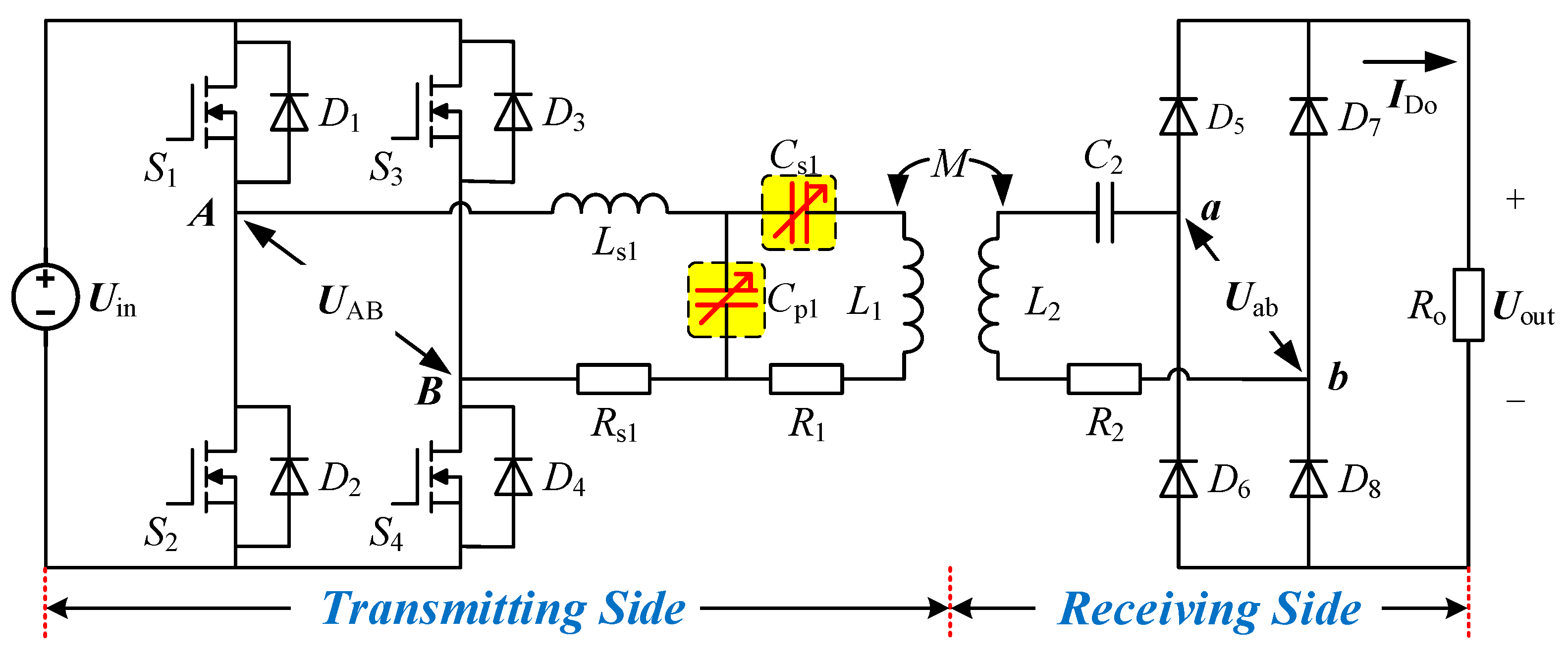



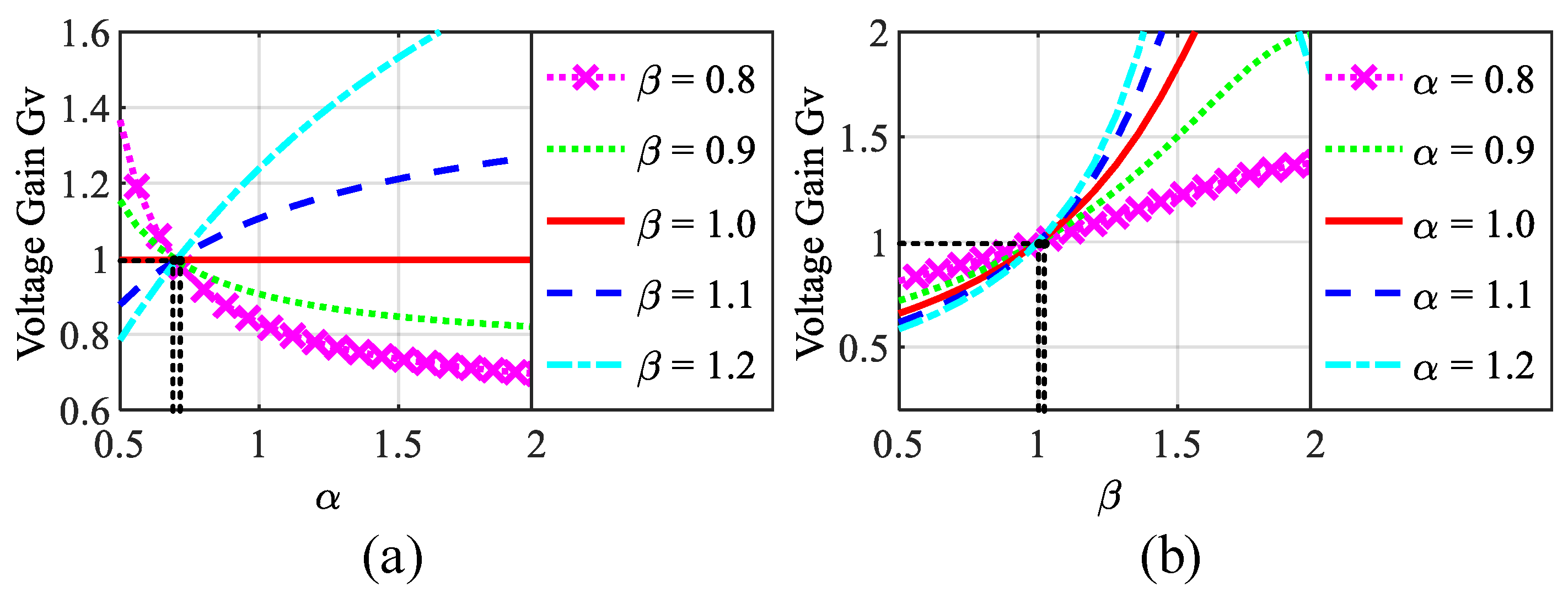
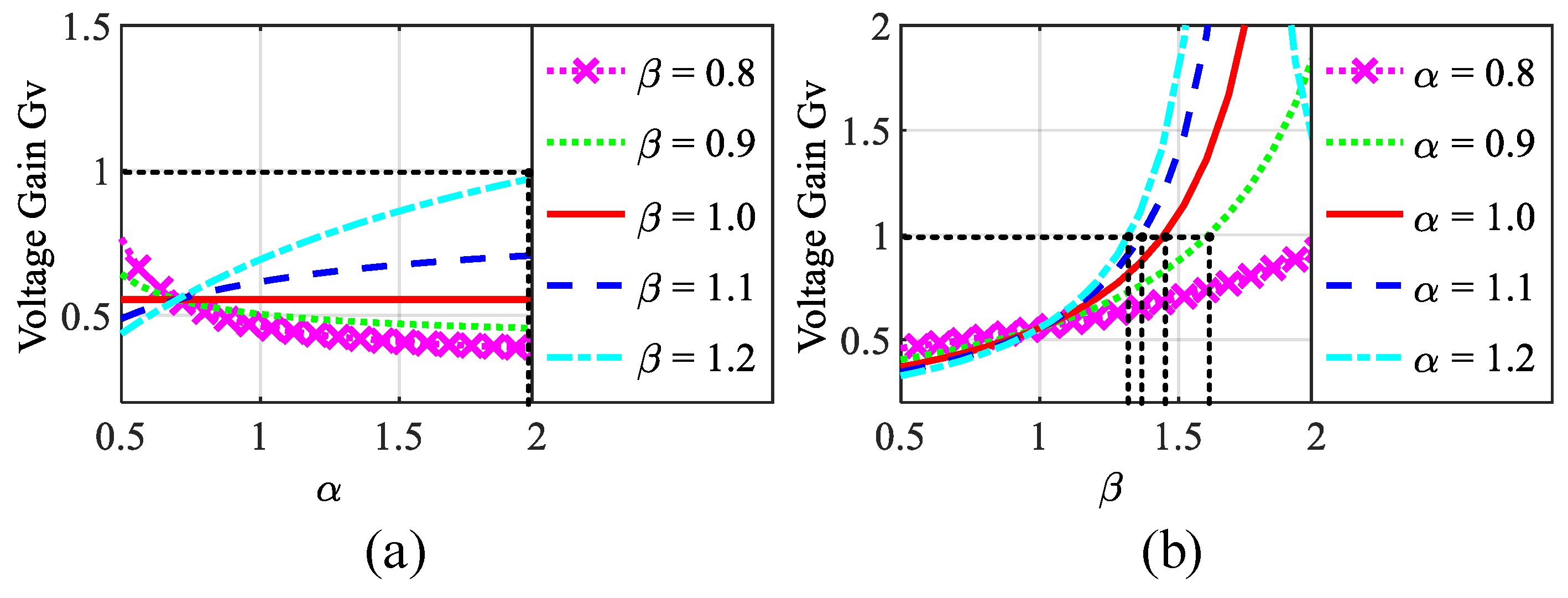

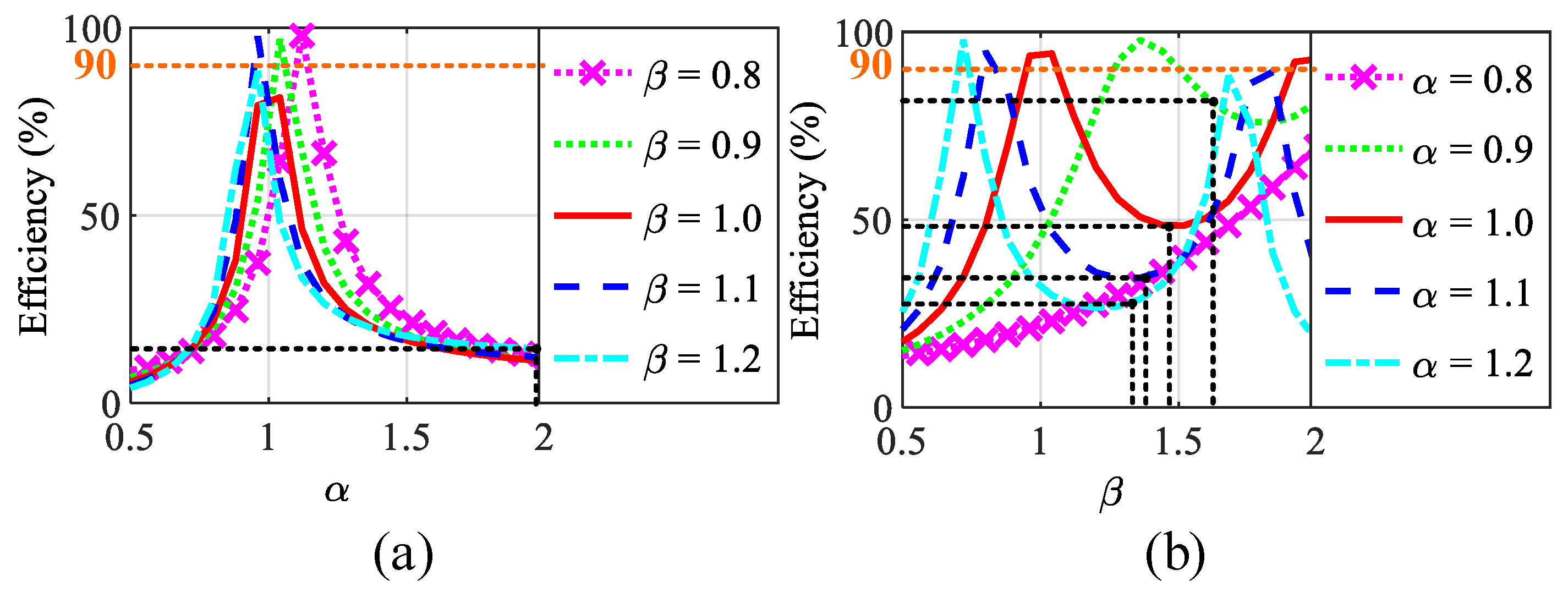
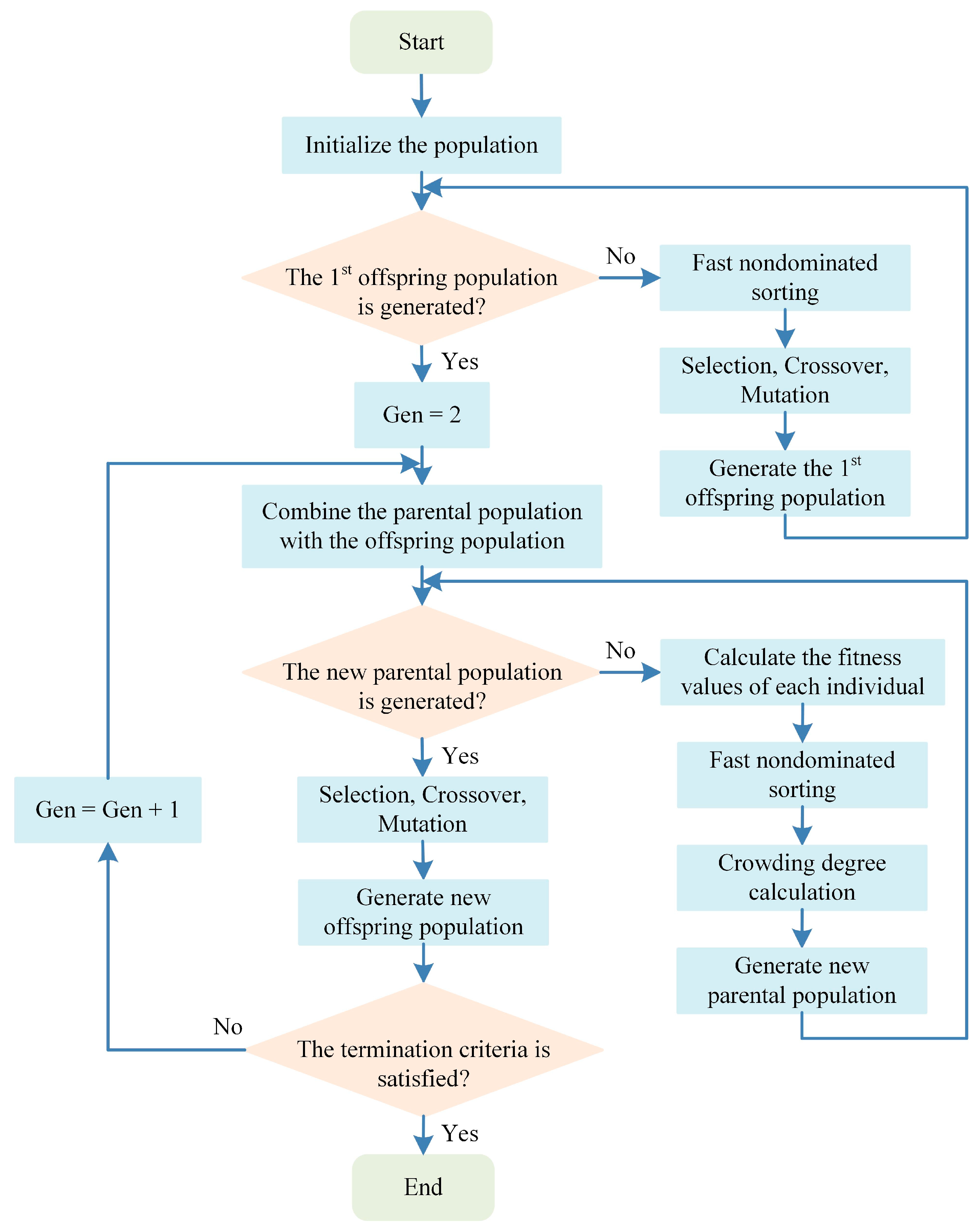
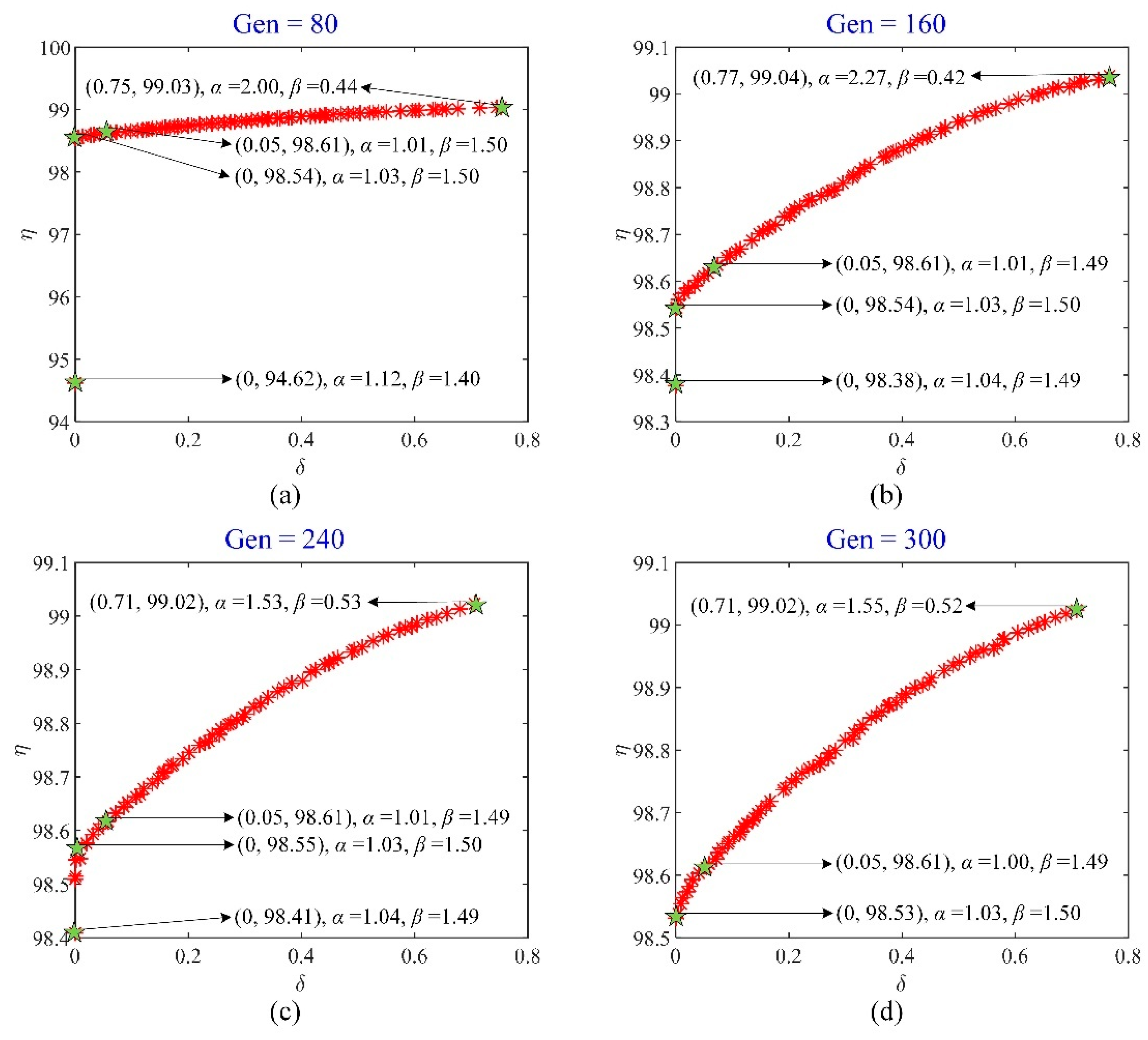
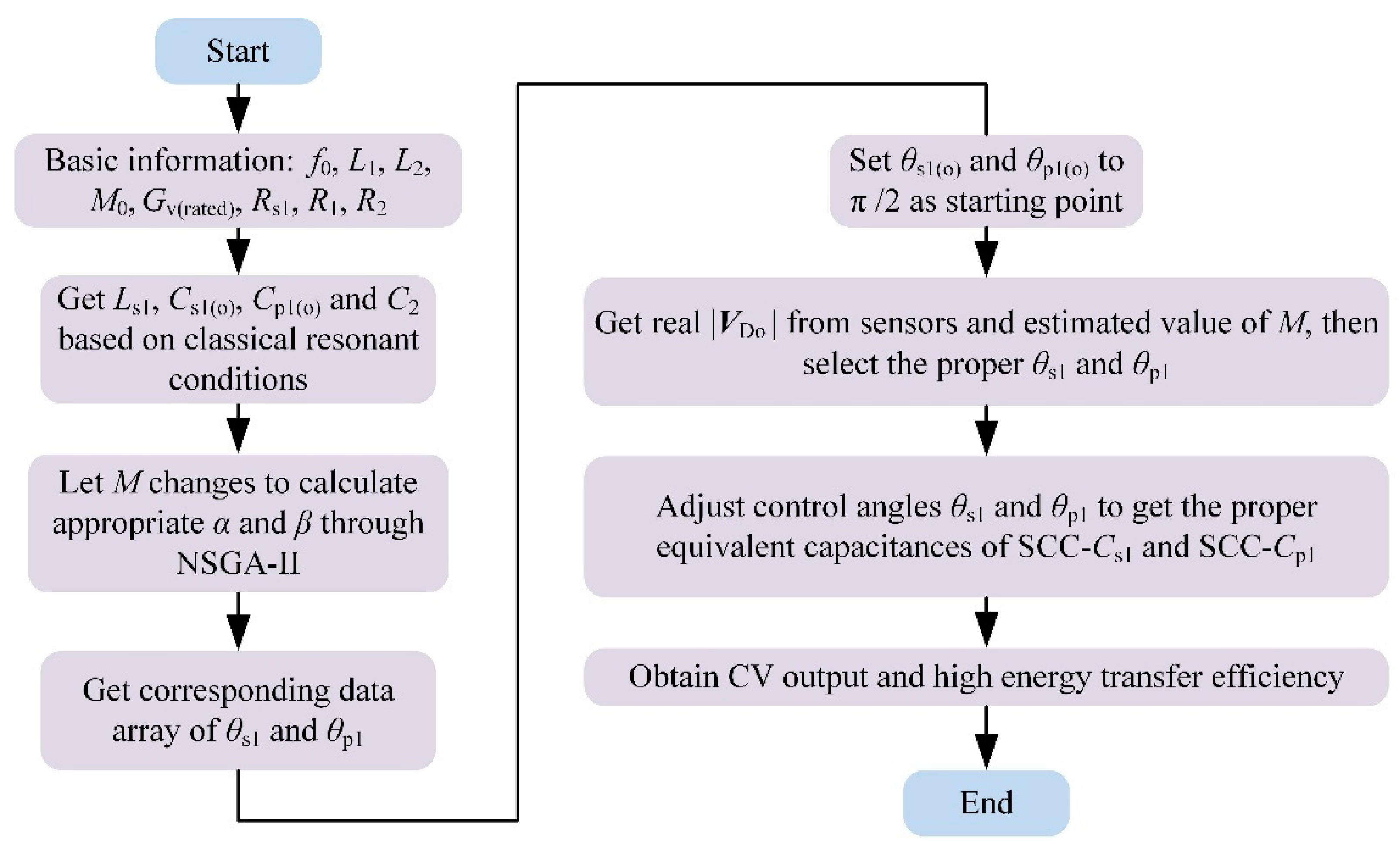
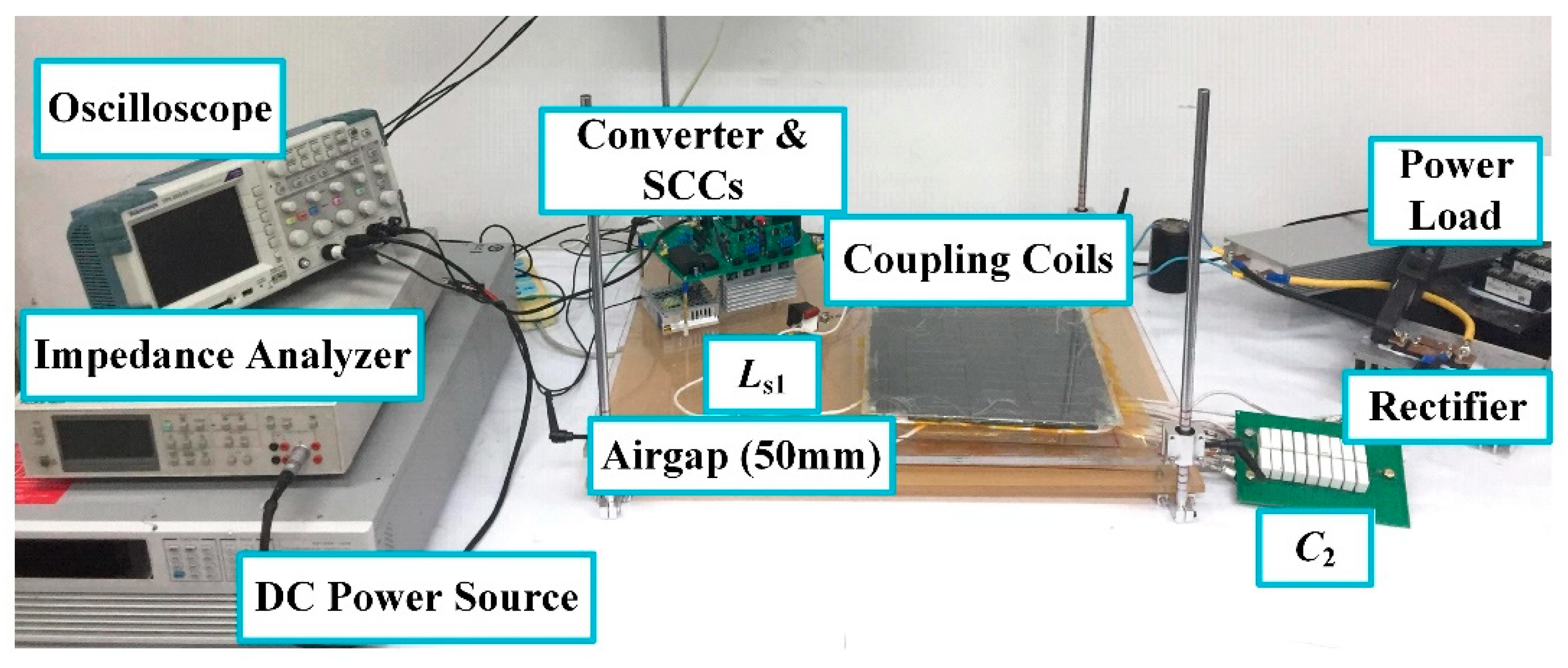

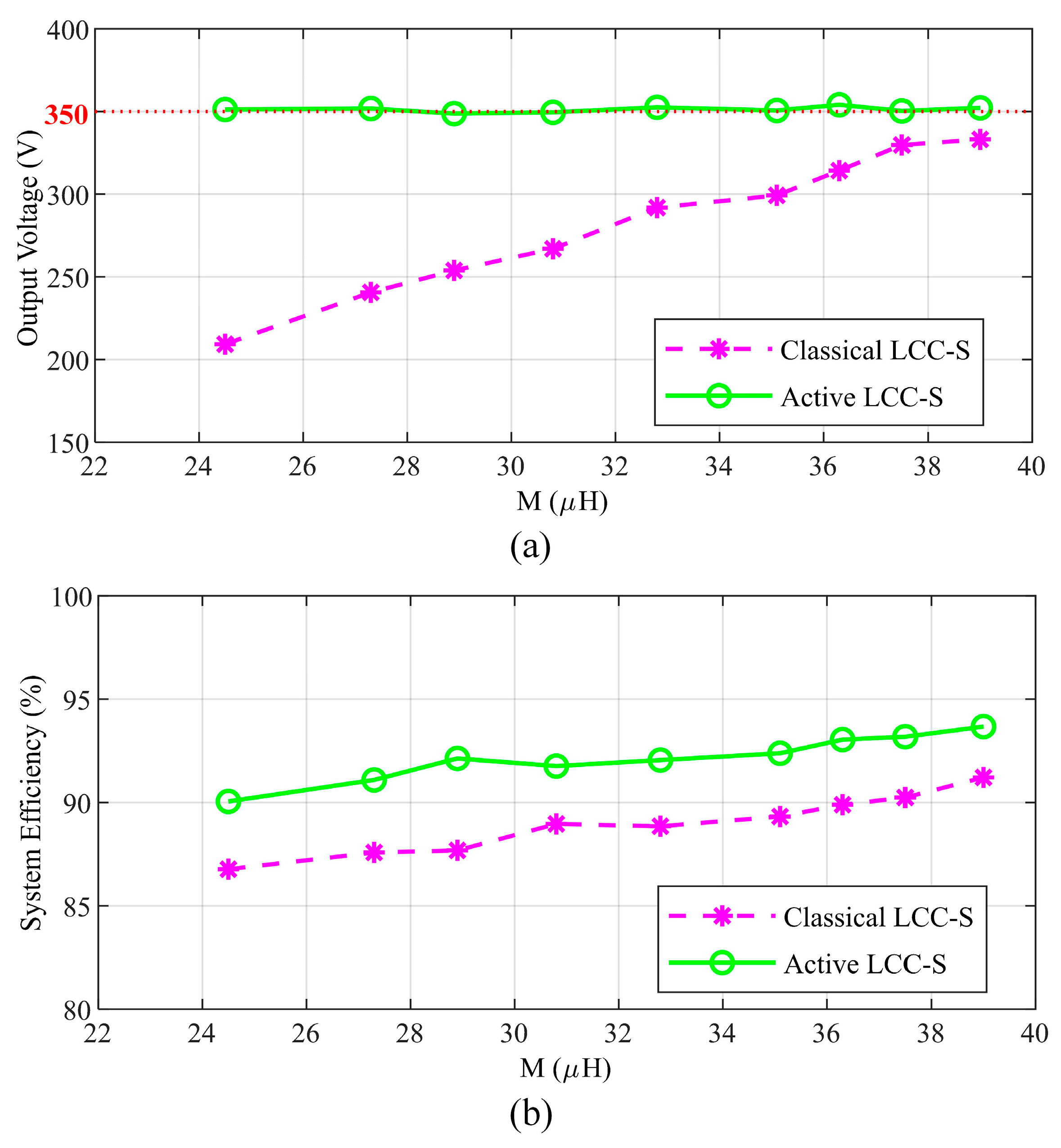
| Symbol | Meaning | Symbol | Meaning |
|---|---|---|---|
| f0 | Switching frequency | j | Imaginary unit |
| Zr | Reflected impedance | Zin | Input impedance |
| α | Detuning coefficient for Cs1 | β | Detuning coefficient for Cp1 |
| Gv | System voltage gain | η | System efficiency |
| Symbol | Value | Symbol | Value |
|---|---|---|---|
| f0 | 85 kHz | L2 | 120 μH |
| L1 | 120 μH | C2 | 29 nF |
| Ls1 | 36 μH | M | 20~36 μH |
| Cs1(o) | 42 nF | k | 0.17~0.30 |
| Cp1(o) | 97 nF | RL | 45 Ω |
| Rs1 | 50 mΩ | R1, R2 | 50 mΩ |
| Parameter | Value | Parameter | Value |
|---|---|---|---|
| Uin | 350 V | Cs1 | 40 nF |
| Uout | 350 V | Cp1 | 95 nF |
| Airgap | 50 mm | L2 | 121.0 μH |
| fsw | 85 kHz | C2 | 30 nF |
| Ls1 | 39.2 μH | M | 24.5 μH~39.0 μH |
| L1 | 125.7 μH | RL | 45 Ω |
Disclaimer/Publisher’s Note: The statements, opinions and data contained in all publications are solely those of the individual author(s) and contributor(s) and not of MDPI and/or the editor(s). MDPI and/or the editor(s) disclaim responsibility for any injury to people or property resulting from any ideas, methods, instructions or products referred to in the content. |
© 2023 by the authors. Licensee MDPI, Basel, Switzerland. This article is an open access article distributed under the terms and conditions of the Creative Commons Attribution (CC BY) license (https://creativecommons.org/licenses/by/4.0/).
Share and Cite
Li, W.; Diao, L.; Mei, W.; Dongye, Z.; Qin, X.; Jin, Z. Optimized Resonant Network Design for High Energy Transfer Efficiency of the WPT System. Electronics 2023, 12, 1984. https://doi.org/10.3390/electronics12091984
Li W, Diao L, Mei W, Dongye Z, Qin X, Jin Z. Optimized Resonant Network Design for High Energy Transfer Efficiency of the WPT System. Electronics. 2023; 12(9):1984. https://doi.org/10.3390/electronics12091984
Chicago/Turabian StyleLi, Weijie, Lijun Diao, Weiyao Mei, Zhonghao Dongye, Xuqing Qin, and Zheming Jin. 2023. "Optimized Resonant Network Design for High Energy Transfer Efficiency of the WPT System" Electronics 12, no. 9: 1984. https://doi.org/10.3390/electronics12091984






